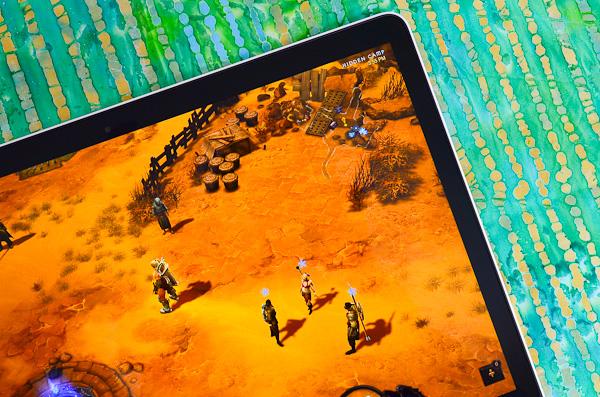The next-gen MacBook Pro with Retina Display Review
by Anand Lal Shimpi on June 23, 2012 4:14 AM EST- Posted in
- Mac
- Apple
- MacBook Pro
- Laptops
- Notebooks
Achieving Retina
To make the MacBook Pro’s Retina Display a reality Apple had to work with panel vendors to build the panels it wanted at a reasonable cost, as well as deliver the software necessary to support insanely high resolutions. There was another problem Apple faced in making the rMBP a reality: the display pipeline of the GPUs Apple wanted to use didn't officially support scaling to the resolution Apple demanded of them. Let me explain.
All modern GPUs have fixed function scaling hardware that is used to efficiently scale between resolutions. A scaler either in your GPU or in your display panel is what lets you run non-native resolutions at full screen on your LCD (e.g. running 1680 x 1050 on a 1920 x 1080 panel). None of the GPUs used in the Retina Display MacBook Pro officially support fixed-function scaling of 3840 x 2400 or 3360 x 2100 to 2880 x 1800 however. Modern day GPUs are tested against 2560 x 1440 and 2560 x 1600, but not this particular 5MP resolution. Even 4K resolution support isn’t widespread among what’s available today. Rather than wait for updated hardware and/or validation, Apple took matters into its own hands and built its own GPU accelerated scaling routines for these higher resolutions. Fixed function hardware is almost always more efficient from a performance and power standpoint, which is why there’s some additional performance loss in these scaled resolution modes.
What’s even crazier is Apple wasn’t pleased with the difference in baseline filtering quality between the Intel HD 4000 and NVIDIA GeForce GT 650M GPUs. As the Retina Display MacBook Pro would have to regularly switch between GPUs, Apple wanted to ensure a consistently good experience regardless of which GPU was active. There are a lot of filtering operations at work when doing all of this resolution scaling, so rather than compromise user experience Apple simply wrote its own default filtering routines. Since you want your upscale and downscale quality to be identical, Apple had to roll its own implementation on both. Apple’s obsessive attention to detail really made it possible to pull all of this off. It’s just insane to think about.











471 Comments
View All Comments
Sunburn74 - Saturday, June 23, 2012 - link
Didn't Anand often say "there are no bad machines, only bad prices"? Don't you have to consider the asking price when a machine is being looked at and how the competition matches up before anointing it the end all of all creations?solipsism - Saturday, June 23, 2012 - link
Aren't the current 15" notebooks with IPS displays and the same size SSDs — but with worse build quality, worse performance, and vastly inferior displays — currently higher priced?An HP EliteBook 8560w — 15.6", IPS display, Intel® Core i7-2670QM (2.20 GHz, 6 MB L3 cache), 8GB RAM — starts at $2189 (with the instant discount) and despite all the other inferior HW comapred to the new MBP only comes with a 500GB 7200 rpm SATA II. SATAII, really?!
So what am I missing that you think Apple's RMBP is overpriced for it's particular category and market segment?
DeciusStrabo - Saturday, June 23, 2012 - link
They are arguably not worse build quality, but better, having shock-protected internals, more interfaces, a option to use a dock, higher level service agreements etc. They are for a different user group (businesses) able to pay higher prices for more (perceived) reliability and flexibility.ananduser - Saturday, June 23, 2012 - link
Your specified model is 1550$. You're wrong.http://h10010.www1.hp.com/wwpc/us/en/sm/WF06b/3219...
solipsism - Saturday, June 23, 2012 - link
No, I clearly specified this model: http://h10010.www1.hp.com/wwpc/us/en/sm/WF06b/3219...ananduser - Sunday, June 24, 2012 - link
Yes...you are correct, but you failed to mention vPro tech(under Processor technology). A crucial feature in business use that does not come on any mac. It is the only difference in the base specs between my listed model and yours. I would say you cherry picked that one. If you choose 8560w and compare you should compare the non-Vpro model(mine).http://en.wikipedia.org/wiki/Intel_vPro A pretty nifty tech, crucial in some areas. Read a little on it and you'll see it's worth the money.
kmmatney - Sunday, June 24, 2012 - link
That model doesn't have an SSD (and I'm not sure about the video card as well).teng029 - Saturday, June 23, 2012 - link
Anand, as per usual, you don't disappoint with your product reviews. Thanks.anactoraaron - Saturday, June 23, 2012 - link
$2200 and they feel the need to nickel and dime me with accessories? No Gigabit - $30 adapter. $10 power adapter for 1st gen Magsafe.But Mac's are often the first to implement the latest and greatest - display's, thunderbolt, etc bringing it to the mainstream since most PC manufacturers want to stay on the low end and keep costs down.
DaveChapin77 - Saturday, June 23, 2012 - link
I think most folks getting this laptop will also have a 27inch thunderbolt display at home or at work. That sucker has all of the old legacy ports you need including the gigabit Ethernet -- not to mention FireWire and 3 USB ports. That monitor even has a power cable so you can leave your laptop one in your travel bag.